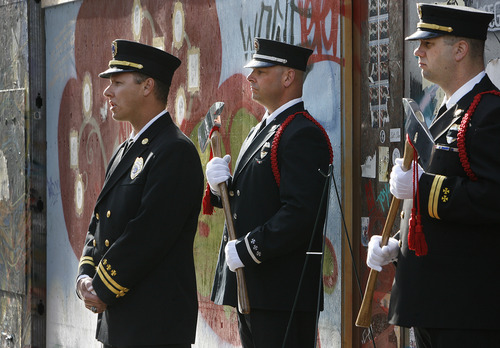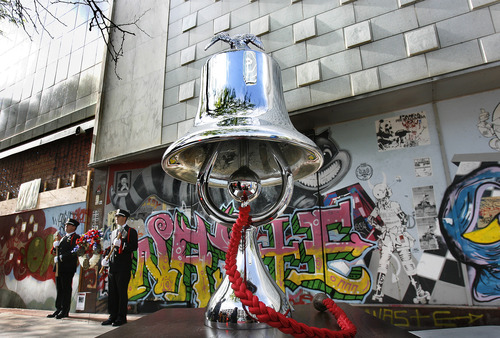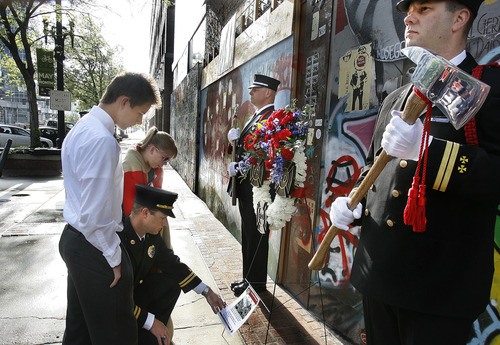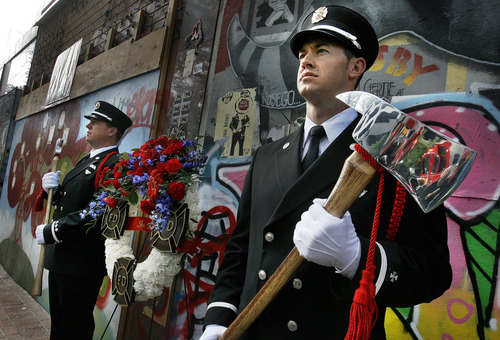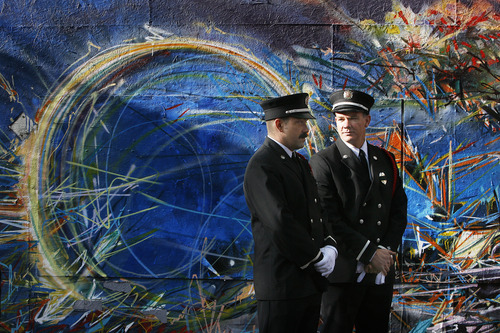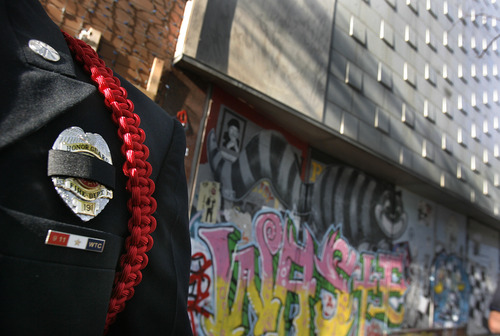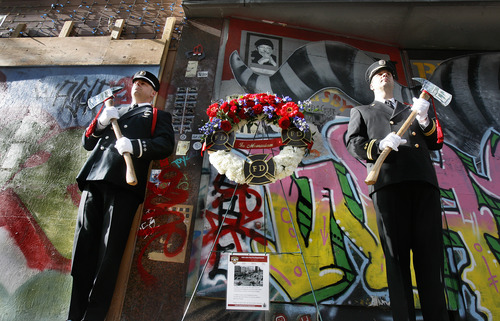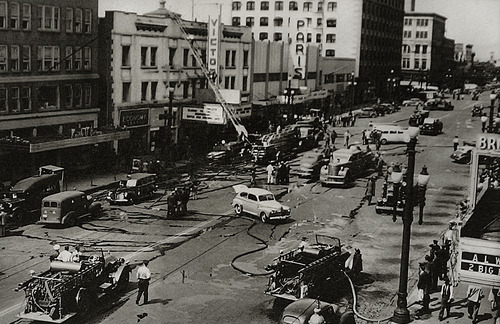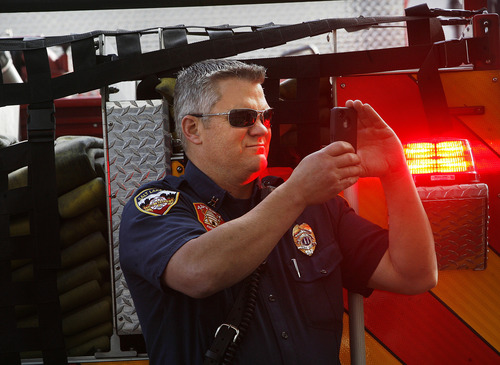This is an archived article that was published on sltrib.com in 2013, and information in the article may be outdated. It is provided only for personal research purposes and may not be reprinted.
There is no marker where the Victory Theater once stood in downtown Salt Lake City. No indication the venue for the first Utah showing of a talking picture — Al Jolson's "The Singing Fool" — on May 22, 1928, ever existed.
No memorial to the three firefighters killed battling the blaze that destroyed the majestic theater on May 19, 1943.
But on Sunday morning, 70 years to the day, the Salt Lake Firemen's Relief Association (SLFRA) gathered in front of the century-old building that remains midblock on the south side of 300 South between State and Main streets. With a vacant structure covered in graffiti as a backdrop, they memorialized the men who gave their lives — Lt. Melvin Hatch and firefighters Harry Christensen and Theron D. Johnson — in the deadliest incident in the history of the Salt Lake City Fire Department (SLCFD).
"We want to remember all the firefighters who lost their lives while protecting the people of Salt Lake City," said Jared Schreiner, a firefighter who is vice president of the SLFRA. "It's been a long time, but we haven't forgotten these men and their families."
While most Utahns have no memory of the Victory or the fire that destroyed it, it's family history for SLCFD Capt. Kyle Lavender. His grandfather, Grant Walker, was among the injured firefighters; his great-uncle, Johnson, was among those killed.
"It was so long ago, it's just kind of been forgotten," Lavender said. "Theron and Grandpa had only been on the job about a year and a half. And [Johnson] left behind a widow and a 15-month-old daughter. The ones left behind are the ones who sacrifice the most."
The sacrifice of the three firefighters was recalled with a brief ceremony that began at 8:24 a.m. — the exact time of the first alarm in 1943. An honor guard stood at attention, a wreath was laid, remarks were made and a bagpiper played.
According to a story that ran in The Salt Lake Tribune the day after the fire: "The three firemen were playing a hose into the blazing interior of the building from inside the foyer near the entrance to the auditorium. The balcony and second floor of the structure caved, trapping the men.
"Fire Chief LaVerre M. Hanson, who was also in the foyer at the time, said: 'We heard their groans, but we were unable to reach them and make a rescue.' "
Nine other firefighters were injured, several seriously.
The fire prompted a banner headline — "$100,000 Fire Takes 3 Lives" — that dominated the front page of the May 20, 1943, edition of The Tribune. Headlines lower on the page included, "Congress Hears Plan to Bomb Axis Out of War," "Nazi Raiders Visit London" and "Flying Forts Blast Two Large U-Boat Yards."
The cause of the fire was never determined, but controversy over the deaths kept the story in the local headlines for months. But the fact that the deadly blaze occurred during World War II may have overshadowed the deaths of the three firefighters.
"With the war going on at the same time, I think it kind of fell into the background a little bit," said SLCFD Battalion Chief Brady George. "We're hoping to shine light on the sacrifice these gentlemen made. And, hopefully, make the citizens in the area aware of what we do. This is still a dangerous job."
On May 19, 1943, firefighters didn't realize the danger that faced them when they arrived at the 1,800-seat theater that stood between the Paris Millinery Co. and the Keith-O'Brien Co.
Constructed in 1908 — before building codes — by the owners of Auerbach's department store as the Colonial Theater, it was also known as the Pantages and the Loews State before becoming the Victory Theater in 1924. Originally the home of live theater and vaudeville, it became a movie house when movies were still silent.
When the theater was retrofitted as a movie house, a concrete floor and heavy equipment were installed on the lower of two balconies, which collapsed and killed the three firefighters.
The streetside portion of the building, which housed the theater entrance, a hotel and retail shops, still stands, hidden under a variety of ghastly 1950s, '60s and '70s remodels. On the rear of the building, you can still see the niches where wooden beams that supported the theater balcony were once attached.
"It was a watershed event for the fire department," Lavender said. "They had to really look at themselves and say, 'Are we doing what we need to be doing?' The fire service started to grow up."
In 1943, firefighters were working 84-hour workweeks for little pay.
"They were almost indentured servants, but they loved their jobs," Lavender said. "We love our jobs. We're proud to serve."
And in the Lavender family, that tradition just might continue. Lavender's 15-year-old son, Christian, has his heart set on becoming a firefighter.
"It's part of our family, and I'm not going to say my father didn't sway me," he said. "But it's such a great environment. It's a home away from home — like a family."
More firefighter memorials
The Salt Lake Firemen's Relief Association plans similar ceremonies for the other 10 city firefighters who died in the line of duty. Next up is a memorial to a death that took place a month after and a block-and-a-half away from the March 19, 1943, Victory Theater fire. Firefighter Paul Hamilton was killed on June 19, 1943, when the ladder on a ladder track collapsed as he was battling a blaze at the Hotel Newhouse. Other memorials are pending.


